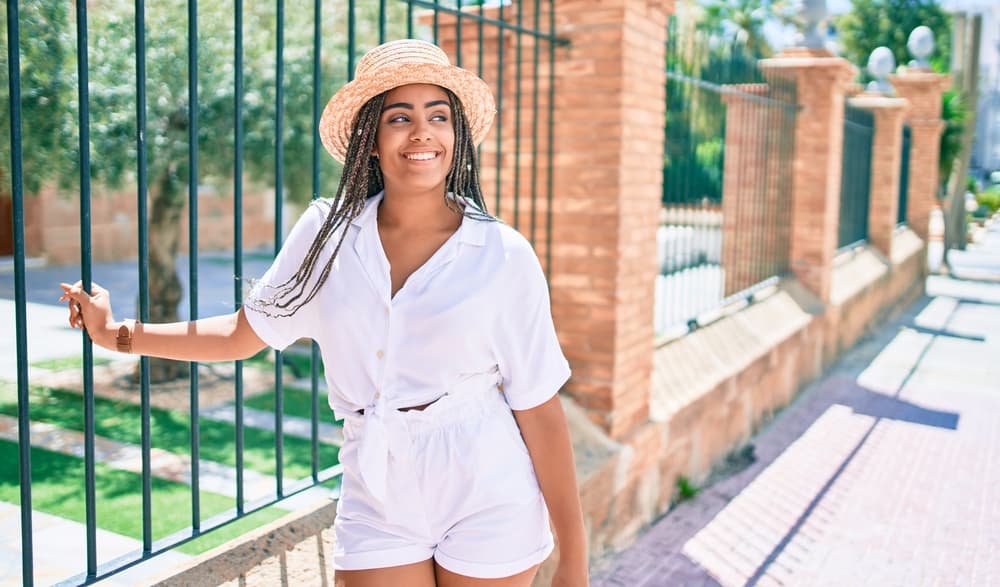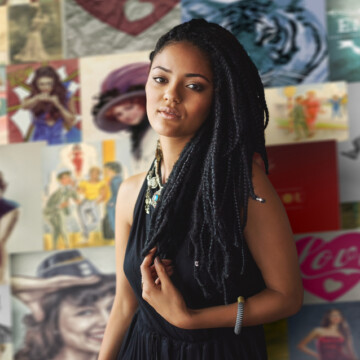
Misinformation is rife in the natural hair community, most likely because so many people are just getting to know their kinks and curls. Questionable information about hair growth miracles pops up on the internet all the time and spreads like wildfire.
One of the most popular myths people believe is that braiding helps your hair grow faster. This is not exactly true, and we’ll tell you why in this article.
Table of Contents
Does Braiding Help Hair Growth?

Braiding your hair doesn't make it grow faster, but there are many benefits to braiding your hair. When braids are used within a coordinated natural hair regimen, there are opportunities to stimulate hair growth and mitigate hair breakage.
However, braids are only one component of a coordinated regimen to promote hair growth.
We’re all intrigued by the possibility of fast hair growth, and there is no shortage of hair growth “miracles” on social media outlets.
In fact, a simple online search for how to grow hair fast will return millions of search results. But what if we told you that braids don’t make your hair grow?
Let us explain.
When you are healthy, your hair grows continuously. The average hair growth rate is about ½ inch per month, regardless of your hair type - some people’s hair grows faster due to genetics and hormones. But one of the main factors you need to pay attention to is length retention.
Length retention refers to maintaining and preserving the hair on your head. Your hair growth goals will remain unattainable without length retention - more on this in the following section.
The Process of Natural Hair Growth

The hair growth cycle follows a very specific process that includes four unique phases. To learn more about how the hair growth process works, click here.
Although, for the purposes of this article you can think about hair growth as a two-step process:
- New hair follicles grow from the scalp following the growth cycle
- Use a hair regimen to remain your existing hair growth or length
Hair growth from the scalp is a natural daily process for healthy individuals, but length retention highly depends on hair care habits.
No matter how fast your hair grows, it'll break off if it's not cared for properly, and there won’t be any visible progress. For your newly-grown hair to translate to noticeable length, your ends must be properly protected, styled, and maintained.
Braiding Does Not Accelerate Growth
So essentially, braiding alone will not accelerate your hair growth rate since the rate is beyond your control. Although, since braiding your hair can help with length retention, so people would argue that braiding promotes hair growth.
Braided hairstyles give your hair a break from frequent detangling, friction, and other sources of manipulation, which are significant contributors to hair damage and breakage.
Unless you're dealing with an issue that is specifically causing hair loss (or hair fall in certain cultures), the truth is that your hair is always growing. The challenge is retaining the hair you grow.
Length retention is vital in achieving your length goals.
Is Braiding Good For Hair Growth?

Now that you know that braiding is not the direct cause of hair growth, you might be wondering if braids are suitable for your hair anyway. When done correctly, braiding is great for your natural hair and can even help you retain length!
There are many diverse braiding styles and techniques. For example, you can wear extension braids or braid your natural hair alone.
Hair extensions are convenient and protective, as they hold the hair in place and prevent it from fraying, slipping, or frizzing. Popular braided styles include knotless or invisible braids, box braids, microbraids, crochet braids, and faux locs.
Braided protective styles give your hair a break from everyday manipulation and friction with fabrics or surfaces. In addition, braided hair is less prone to tangles, matting, and mechanical damage.
For more information, read this article on how to create a protective hairstyle. Protective styles are a great way to encourage hair growth when combined with a healthy hair growth regimen.
When is Braiding Bad for Your Hair?
The problem with braids is that they are not always done correctly or at the right time, which can cause extensive damage and decrease length retention.
Below are a few scenarios when braids are bad for your hair:
- After a relaxer. Hair becomes fragile after a chemical relaxing session, and braiding your hair can damage it further in its weakened state.
- While it’s wet. Braiding hair when it's wet can be damaging because wet hair is fragile and can break easily. So, it’s best to allow the hair to dry before you start braiding it.
- Immediately after bleaching it. Bleaching changes the hair’s structure making it more prone to damage, and braids can worsen the damage. Learn how to lighten hair without bleach with our DIY guide.
- When it’s done too tightly. Tight braids can lead to a plethora of scalp and hair issues, ranging from scalp irritation and bumps to traction alopecia.
- If your hair is thinning. No matter how gently you braid, braids tug on your scalp and can make thin hair even thinner. If your hair is thinning, you should take a break from any styles that can be even remotely rough on your hair. Low manipulation styles (often called a protective style) are much better for thinning hair than styles that can create frictional breakage.
- When you leave them in too long - Long-term protective styles, like box braids, micro braids, Senegalese twists, and butterfly locs can be left in for a month or two. However, when you leave them in too long, there’s a chance of hair loss and breakage during the takedown process.
If any of the above apply to you, don’t feel down on yourself. We all make mistakes during our natural hair journeys! The following section will help you make some positive changes.
Dos And Don'ts To Promote Hair Growth
To retain as much length as possible and minimize breakage, it’s essential to learn good braiding practices. Otherwise, your efforts to protect your hair could turn out to be counterproductive.
If you want to avoid damaging your hair in an attempt to protect it, read the following list of the dos and don'ts of braiding.
Dos to Stimulate Hair Growth
- Do wash your hair before installing braids. If you're getting your hair braided it's important to wash your hair in advance. It's the best way to ensure that you're not trapping dirt and product build-up in your hair during the braiding process.
- Do opt for medium to thick extension braids whenever possible. Larger braids are usually done on thicker sections of hair, which can handle the weight of extensions better than thinner sections. If you're interested in tiny braids, we would encourage you to consider wearing sisterlocks.
- Do switch up your style every so often to avoid putting prolonged pressure on certain parts of your hair. But at the same time, you should also avoid changing up your hairstyle too often (every couple of days is too often). The key is to use braids to provide a stable structure that allows your hair to grow without too much daily wear and tear causing your hair strands to potentially break.
- Do be gentle when pulling your braids up into ponytails and updos. It’s important to keep pulling to a minimum to avoid stress and breakage around your hair roots.
Don’ts to Minimize Damage and Avoid Hair Breakage

- Don't neglect your hair once it's braided. Protective styles require regular care and maintenance, just like your natural hair does. Therefore, it’s crucial to stay on track with your hair care regimen. Moisturize your scalp and cover your head with a silk or satin scarf at night. Some women use a silk pillowcase at night. You should also avoid cotton pillowcases and headwraps, as they can absorb hair moisture and make your hair bone dry.
- Don’t braid hair without detangling it first. Struggling to braid tangled hair can lead to unnecessary pulling and breakage. Always detangle your hair gently before braiding it.
- Don’t allow an inexperienced person to braid your hair. If you are allowing someone else to braid your hair, make sure that they are aware of the above dos and don’ts and have some experience braiding hair. If at all possible, choose a certified braider.
- Don’t tug or play with your braids after they're done. If you’re constantly touching and playing with your hair after it’s done, you could be causing extra stress to your roots. This can lead to breakage at the roots, cause split ends, and reduce the longevity of your style.
Conclusion
Now you know that braids cannot speed up hair growth and that your genetic makeup determines your hair growth rate to a large degree.
You have no control over genetics, and hormones can be affected by various factors such as age, health, nutrition, and the environment.
So, aim to concentrate on what you can most easily control, which is length retention. This is the best way to create long hair.
We recommend reducing stress levels, eating a balanced diet, using scalp massages, limiting heat styling, and avoiding chemical treatments that damage your hair.
You'll also want to create a hair regimen that encourages healthier hair. Also, whenever you braid your hair, be sure to follow the guidelines we’ve included in this article.
Doing so will help ensure that your braided protective styles are actually protective, prevent hair breakage, and don’t sabotage your hair growth goals. We hope that this article is helpful to you on your hair growth journey!




